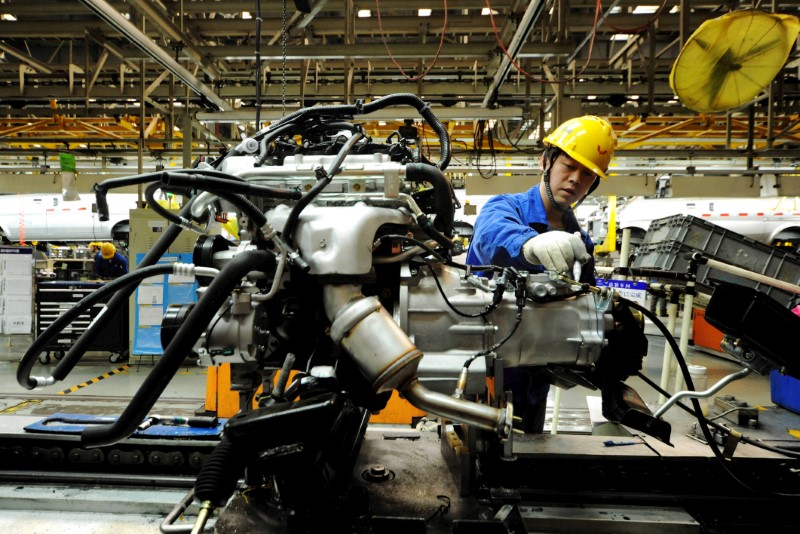By Saikat Chatterjee
HONG KONG (Reuters) - Asian factories extended a global manufacturing revival as activity picked up steam in February, though the outlook for many of the region's export-reliant economies remained uncertain in the wake of U.S. President Donald Trump's protectionist stance.
Manufacturing surveys for Asia, including for its two biggest economies China and Japan, showed a broadly positive impulse for exports in a welcome sign for many of the companies tapped into the global supply chain.
"Encouragingly, the data indicated that the current upturn in demand remains broad-based across both domestic and international markets, while a further steep increase in purchasing activity raises the prospect of continued production growth in coming months," said Annabel Fiddes, economist at IHS Markit, referring to Taiwan's strong PMI reading.
Trump, however, remained the great unknown risk factor for Asia and the rest of the world.
In a key speech to Congress, the U.S. president outlined his plan for his first year in office that included healthcare and tax reforms, but he did not announce anything new on trade.
Trump's protectionist stance has rattled global markets, with policymakers and investors remaining on edge until they see more clarity, and specific details, on U.S. economic policies.
Authorities in China, whom Trump last week labeled the "champions of currency manipulation", can take comfort from a private survey showing factory activity expanded for an eighth consecutive month thanks to a pick up in export orders.
Zhou Hao, an economist at Commerzbank (DE:CBKG) expects "bubble deflating" will remain a key theme at the upcoming National Congress, underscoring challenges for policymakers in China as an explosive rise in debt in recent years has stoked speculative asset bubbles.
That explains why Beijing plans to slightly lower its target for broad money supply growth to 12 percent, as authorities adopts a modest tightening bias in a bid to cool strong credit growth. It raised interest rates on a key funding tool in January.
FED FACTOR
India also benefited from a rebound in global demand with activity expanding for a second month, not entirely surprising given data a day earlier showed annual growth expanded 7 percent, though the strong number raised scepticism among economists on the quality of the figures.
Of greater concern was the rate of increase in output prices, as a sub-index measuring costs paid by customers grew at its fastest pace in nearly three and a half years in a sign of rising inflationary pressures.
The encouraging factory activity in Asia should also be squared off against rising interest rates in the United States, where any tempering in activity could prove detrimental to some of the region's globe-trotting manufacturers.
A handful of Federal Reserve policymakers on Tuesday jolted markets into higher expectations for a March U.S. interest rate increase, with comments that suggested rate-setters were worried about waiting too long in the face of pending economic stimulus from Washington.
Similar surveys later in the day are expected to show solid growth in manufacturing in Europe and the United States.
China's exports, which have lagged its regional counterparts in recent months, showed signs of a pickup with the Caixin PMI sub-index for new export orders rising to 53.8, the highest rate of growth since September 2014.
That bounce in new orders was echoed in South Korea where exports grew at their fastest pace in five years supported by a pickup in global demand and from China.
The trade ministry said exports to China, South Korea's biggest customer, rose for a fourth straight month while semiconductor exports posted their best monthly performance on record, riding on a months-long rally in electronics.
"February data shows that there is a clear export resurgence, as exports in terms of both price and volume seem to be increasing," said Lee Sang-jae, an economist for Eugene Investment & Securities in Seoul.
In Japan, the picture was mixed, even as a pick up in manufacturing activity at its fastest pace in three years was accompanied by strong export orders. Question marks remain about domestic demand, and shipments to the U.S., which have failed to show strong growth in the past year.
Indeed, January exports growth slowed and data on Tuesday showed factory output unexpectedly fell for the first time in six months in Japan while headline PMI figures out of China showed signs of slowing.
In Australia, investors had a lot to cheer as data showed the economy rebounded sharply last quarter thanks to a boom in commodity exports, extending the resource rich nation's 25-year streak of uninterrupted expansion.
An uptick in momentum in China, Australia's major export market, is another reason for the Reserve Bank of Australia to hold off on more rate cuts this year.
"Looking ahead, with domestic monetary policy set to remain loose and global growth likely to pick up a bit this year, we expect a gradual recovery in Asian manufacturing ahead," said Krystal Tan, Asia economist at Capital Economics.
